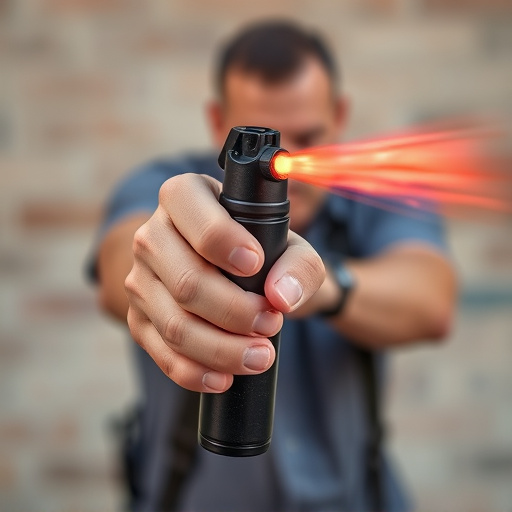Proper pepper spray storage is essential for maintaining its effectiveness, safety, and legal use. Keep it in a cool, dry place (2-5 years shelf life), away from heat/sunlight, out of reach of children, and regularly inspect for damage or leakage. Adhering to these guidelines ensures optimal performance when needed.
“Uncover the power of self-defense with a comprehensive guide to pepper spray. From understanding its potent ingredients to mastering safe storage techniques, this article equips you with vital knowledge. Learn how environmental factors influence shelf life and discover simple maintenance routines. Additionally, explore legal considerations and usage guidelines to ensure responsible carrying. Maximize your peace of mind and stay prepared with our expert insights on pepper spray storage, self-defense, and longevity.”
- Understanding Pepper Spray: A Self-Defense Tool
- How to Store Your Pepper Spray Safely
- Factors Affecting Shelf Life of Pepper Spray
- Regular Maintenance and Care Tips
- Legal Considerations and Usage Guidelines
Understanding Pepper Spray: A Self-Defense Tool
Pepper spray, a powerful self-defense tool, has become a popular choice for personal safety. It is designed to temporarily incapacitate an attacker by causing intense irritation and pain in the eyes and respiratory system. This non-lethal weapon is widely used by law enforcement and civilians alike due to its effectiveness in disorienting assailants, allowing users to escape or seek help.
When considering pepper spray as a self-defense mechanism, understanding its storage and shelf life is crucial. Pepper spray should be stored in a cool, dry place, away from direct sunlight and heat sources. Proper storage ensures optimal performance and longevity. Many manufacturers recommend keeping the can upright and securely closed when not in use. Regularly checking the expiration date is essential, as pepper spray has a limited shelf life, typically ranging from 2 to 5 years, depending on the brand and quality. Ensuring its freshness guarantees maximum potency and reliability when needed most.
How to Store Your Pepper Spray Safely
Storing pepper spray safely is paramount to ensure its effectiveness and longevity. The device should be kept in a cool, dry place away from direct sunlight or extreme heat. Ideal storage locations include locked cabinets, glove compartments, or hidden pockets in your home or vehicle. Avoid storing it near food or beverages as chemical residues could contaminate edible items. Keep the spray out of reach of children and pets to prevent accidental use or ingestion.
When not in use, pepper spray typically has a shelf life of 2-3 years. Always check the manufacturer’s instructions for specific guidelines on usage and expiration. Regularly inspect your device for any signs of damage or leakage. If the spray becomes contaminated or its potency decreases, replace it promptly to maintain optimal self-defense capabilities.
Factors Affecting Shelf Life of Pepper Spray
The shelf life of pepper spray is influenced by several key factors. One of the primary considerations is storage conditions. Extreme temperatures, both hot and cold, can significantly reduce its effectiveness. It’s recommended to store pepper spray in a cool, dry place, away from direct sunlight. Humidity levels are also crucial; high humidity can affect the spray mechanism and reduce overall performance.
Additionally, exposure to moisture, chemical substances, or physical impacts can impact the spray’s shelf life. Proper pepper spray storage involves keeping it sealed and intact to prevent any external contaminants from entering. Regular maintenance checks and adhering to manufacturer guidelines are essential practices to ensure optimal performance when needed.
Regular Maintenance and Care Tips
Proper storage and maintenance are crucial for ensuring the effectiveness and longevity of your self-defense inflammatory spray device, including pepper spray. Store it in a cool, dry place away from direct sunlight or extreme heat sources. Avoid leaving it in your car, as temperature fluctuations can damage the cartridge. Keep it out of reach of children and unauthorized individuals to prevent accidental discharge.
When not in use, keep your pepper spray in its original packaging with the nozzle protected. Regularly check for any signs of damage, corrosion, or leakage. If you notice any issues, dispose of the spray safely according to local regulations. For optimal performance, consider replacing the device after its shelf life has expired, typically ranging from 2 to 5 years, depending on the manufacturer’s instructions and storage conditions.
Legal Considerations and Usage Guidelines
When considering a self-defense inflammatory spray device, it’s crucial to understand the legal landscape surrounding their use. The legality of pepper spray varies significantly by jurisdiction, with some regions permitting its civilian use while others restrict it to law enforcement and military personnel. Even within legal boundaries, specific regulations dictate where and how these devices can be carried and deployed. Users must familiarize themselves with local laws and adhere strictly to usage guidelines.
Proper storage and knowledge of pepper spray’s shelf life are essential components of responsible ownership. Pepper spray should be kept in a secure, dedicated container, away from heat sources and direct sunlight to maintain its potency. It is recommended to check the expiration date regularly, as chemical effectiveness diminishes over time. Understanding these considerations ensures that individuals are equipped with a viable self-defense tool while operating within legal boundaries and maintaining personal safety.
In conclusion, pepper spray is a powerful self-defense tool that can provide vital protection in dangerous situations. Understanding its proper storage, shelf life, maintenance, and legal usage guidelines is essential for ensuring its effectiveness and safety. By adhering to these practices, individuals can maximize the potency of their pepper spray and feel more secure while carrying it. Remember, knowledge and responsible handling are key when it comes to pepper spray storage and shelf life management.
